When it comes to the use of herbs and spices, many of us think we’ve got it down pat. I know there was a time when I thought I was doing it right by shaking in some chili powder and dried oregano when finishing a dish to try and bring out more flavor. It turns out that I didn’t know the half of it. Now that I am older and wiser, I have acquired some rather valuable knowledge on the topic of herb and spice usage. I'd like to share this knowledge so that you also can maximize the flavor potential and shelf life of your fresh herbs and spices.
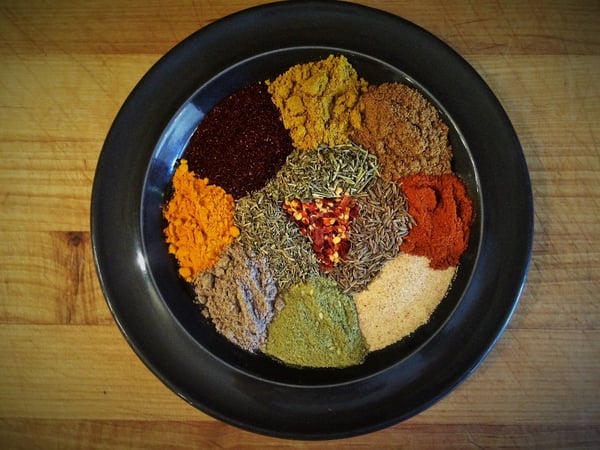
Classifying Herbs
Let’s start by talking about the two classifications that most herbs fall into and why that matters. First, there is what are called robust herbs, also commonly known as resinous herbs.
Below are some common characteristics you will find in most robust herbs:
• Won’t bruise or oxidize easily
• Stronger flavors
• Thicker, woody stems
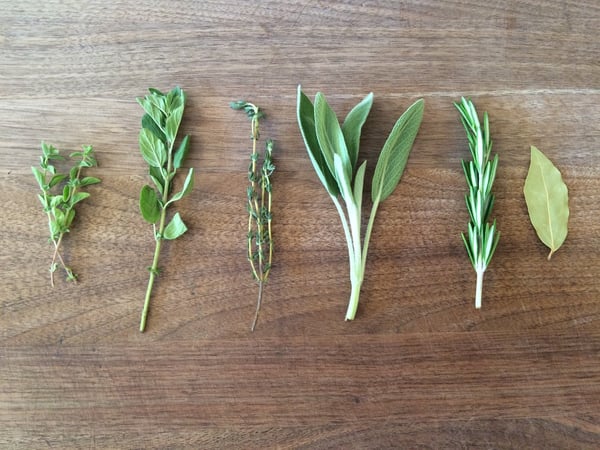 Robust herbs pictured from left to right – Marjoram, Oregano, Thyme, Sage, Rosemary, Bay Leaf
Robust herbs pictured from left to right – Marjoram, Oregano, Thyme, Sage, Rosemary, Bay Leaf
Secondly, you have tender herbs, which go by a number of other names, such as: “fines herbes”, noble herbs, or delicate herbs.
Some common characteristics of tender herbs include:
• Higher moisture content
• Bruises easily
• Most have delicate, edible stems
Try to avoid chopping your herbs to a pulp, especially those of the tender variety. The more moisture content you release, the more you are bruising the herbs and draining out all of their fresh flavor. You can tell when you’ve over-chopped an herb when a green residue starts to show up on your cutting board and your herbs start to stick to your knife with more rigor. 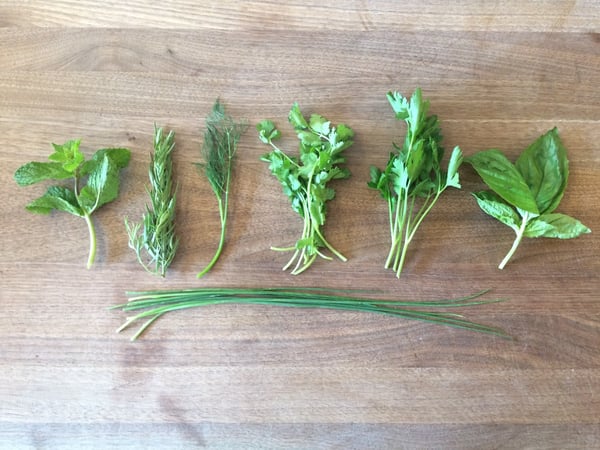
Tender herbs pictured from left to right – Mint, Tarragon, Dill, Cilantro, Parsley, Basil & Chives
While technically classified as a vegetable, green onions or scallions could almost be considered a hybrid between robust and tender herbs. The green section of the scallion can be likened to a tender herb, while the white section of the scallion falls closer in line with the characteristics of a robust herb. More on why that matters can be found in the following section. 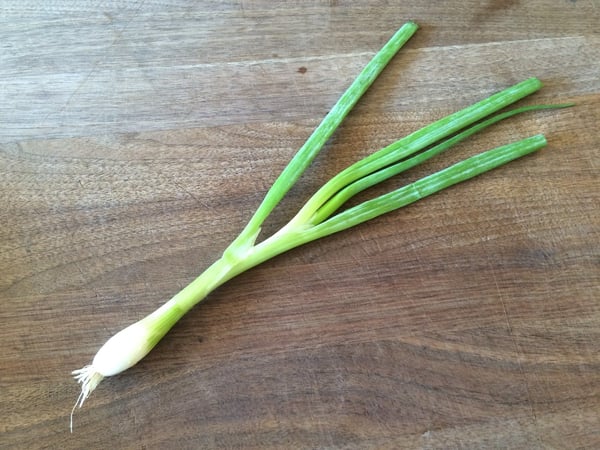
Cooking with Herbs & Spices
Much like tea leaves are steeped in water to strengthen a tea, the flavors and aromas of spices will be strengthened tenfold with longer cooking times and can be further extracted when toasted in oil. This is because the majority of spices are oil soluble. Simply adding spices at the end of the cooking process is not enough to fully unlock their potential. 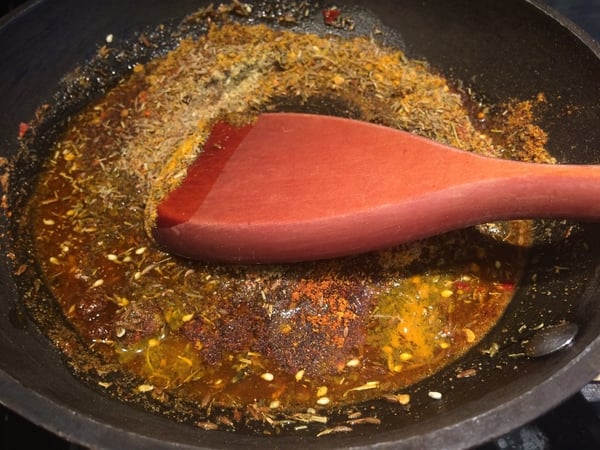 When it comes to fresh herbs, the time at which you add them in the cooking process is dependent on the type of herb you are using. The rule of thumb tends to be that robust herbs can withstand longer cooking times, and the flavor properties are enhanced as they interact with the prolonged temperatures. Tender herbs, on the other hand, should never be added at the beginning of the cooking process. These herbs are water soluble and their delicate nature cannot hold up to the cooking process. Instead, their bright, beautiful essence would waste away, which is why it is best for tender herbs to always be added at the very end of cooking for their fresh flavor profile to shine through.
When it comes to fresh herbs, the time at which you add them in the cooking process is dependent on the type of herb you are using. The rule of thumb tends to be that robust herbs can withstand longer cooking times, and the flavor properties are enhanced as they interact with the prolonged temperatures. Tender herbs, on the other hand, should never be added at the beginning of the cooking process. These herbs are water soluble and their delicate nature cannot hold up to the cooking process. Instead, their bright, beautiful essence would waste away, which is why it is best for tender herbs to always be added at the very end of cooking for their fresh flavor profile to shine through.
Circling back to what this means for the scallion – because the distinctions of the green part of the scallion are more in line with tender herbs, this is better to add at the end of cooking; and, because the white part of the scallion identifies more with the qualities of a robust herb, it should be added in toward the beginning of the cooking process. The white part of the scallion does differ in the fact that at this point, it will act more like the vegetable it is, where it will soften and sweeten in flavor as it is cooked, rather than become more pungent.
While these methods are all great for maximizing the flavor of your herbs in the cooking process, a lot of advanced legwork can also be done to make sure you’re getting the most out of your herbs and spices.
Storing Herbs & Spices
Something that can be rather demoralizing after an impassioned trip to the grocery store is to find just a few days later, a soggy mess of rotten herbs in the depths of the fridge that you had every good intention of using within the week. The good news is that with a few modifications to your herb-storing procedures, you will be able to prolong the life of most of your herbs, so they are lasting a good 3 weeks or more.
The two methods that I know to be most effective are as follows:
- Remove rubber band or twist tie from herb bundle. Split your herb bundle into 2-3 sections, and wrap each section in a dry paper towel. Make a couple slits in a plastic bag and seal the paper towel-wrapped herb bundles in the plastic bag. The slits will allow any remaining moisture to escape so condensation does not build in the bag, leading to quicker rotting times.
- Your second option is to once again remove the rubber band or twist tie from the herb bundle. Next, put an inch or so of cold water in a glass, mason jar, or deli container, and place the herb bundles in the container with the base of the stems submerged in the water. Lastly, cover the tops of the herb bundle with plastic wrap, a lid, or place a plastic bag over the top and seal it to the container with a rubber band.
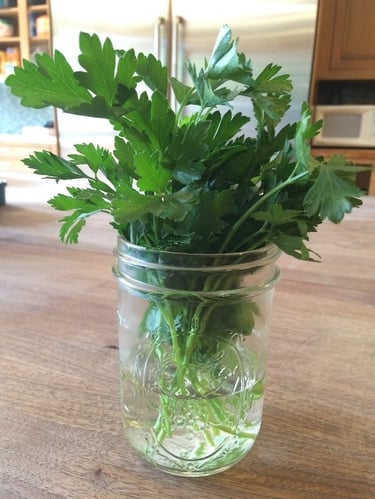
The second option is better for keeping tender herbs fresher for longer, but the paper towel method is a good, all-purpose method for all herb types that also takes up less real estate in the fridge. Basil, however, is very sensitive to the cold, so this is one exception to keep in mind. Basil should instead be stored at room temperature, or if it is being stored in a refrigerator, a paper bag should be wrapped around its packaging as an added blanket of protection from the cold of the fridge.
Spices are a much easier bear to tackle. The most important traits for a spice storage space are that it is a cool, dry place, and that the spices are sealed tightly in containers. How long the spices can be stored and still retain their strong qualities is dependent on the type of spice in question.• Ground spices will last right around 2-3 years
• Dried herbs (parsley, thyme, oregano, basil) last in the realm of 1-3 years
• Whole spices and seeds (i.e. fennel, coriander, cumin, and sesame seeds) last twice as long at around 4 years.With the shelf life of whole spices being double that of pre-ground spices, it is important to talk more about their benefits. While pre-ground spices can be rather convenient, the strength of the flavor and aroma dwindles greatly as it sits. Because of this, the absolute trifecta of spice idealism is achieved when you:
1. Buy whole spices instead of ground.
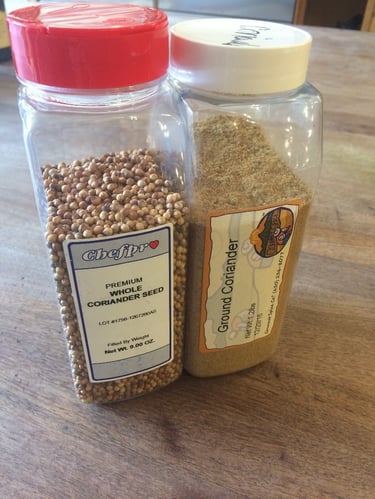
2. Toast your spices.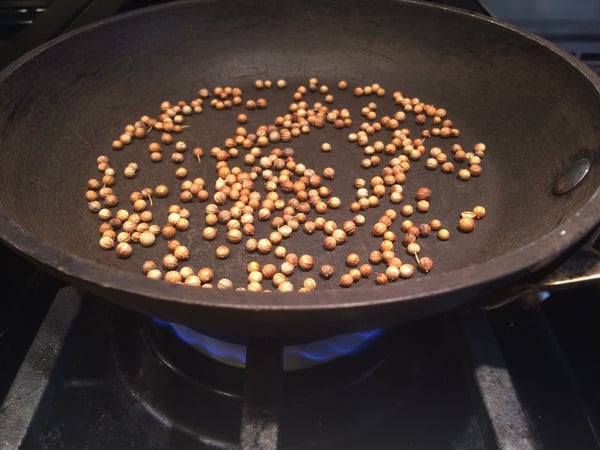
3. Grind your spices fresh upon each use (this can be done using a mortar & pestle, a spice grinder, or a meat mallet).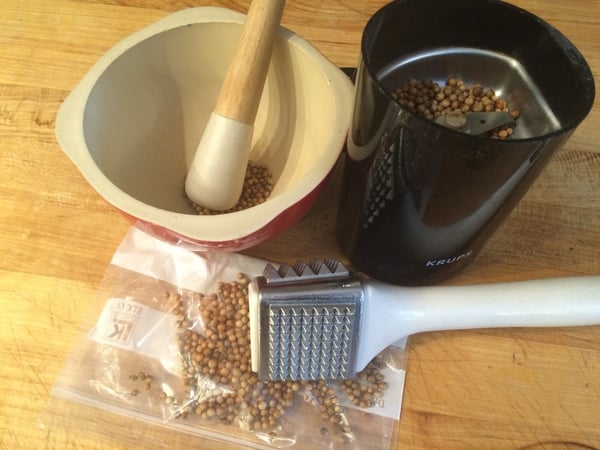
The result will be a spice whose flavor and aroma pack a punch, adding an inviting depth of complexity to your dish.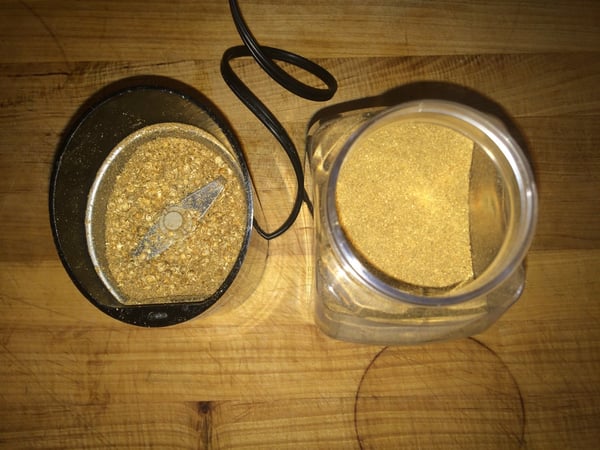
In other cases where the whole spice is larger and only needed in small doses, as is the case with nutmeg, you can simply run a few passes over a zester for a fine grating of the spice.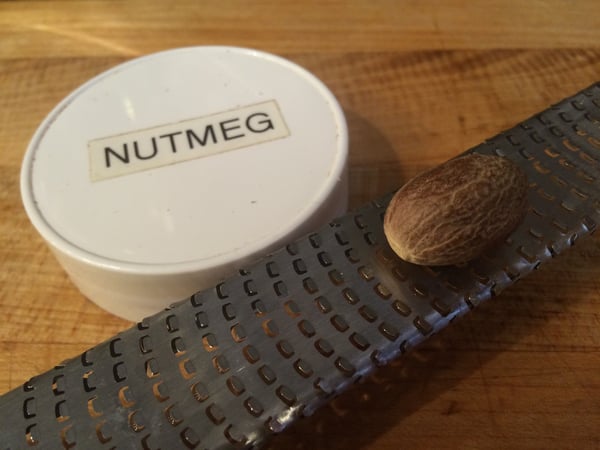
Purchasing Spices
One of the biggest mistakes most of us make with our spices is that we hoard them and hold onto them for far longer than we have any business doing. I’ll admit it; I do it! The trick to this is to buy meager amounts of spice instead of purchasing in larger quantities that will never end up being used in a reasonable amount of time. Luckily, there are some really great shops and stores out there to help you in your quest for spice freshness. My favorite go-to places are Savory Spice Shop (just a couple doors down from The Chopping Block's Lincoln Square location) and the bulk section that can be found at some Mariano’s stores (like the one on Lawrence & Ravenswood in Chicago). Both of these places allow you to buy small amounts of spice at a time and at a reasonable price.
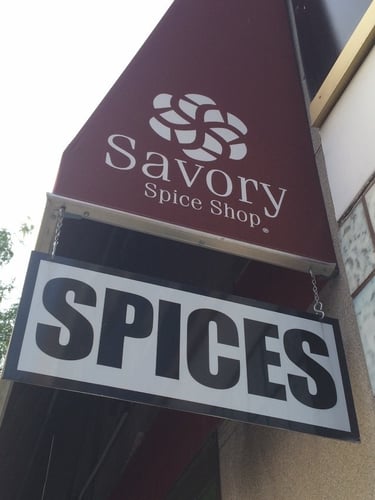
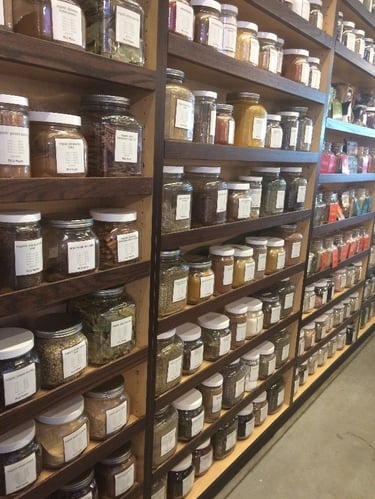
Using Salt & Pepper
After all this talk about herbs and spices, I would be remiss if I didn’t at least briefly touch upon the use of salt and pepper. Black pepper is a spice, and a common one at that; however, salt is considered neither a spice nor an herb – salt is a mineral. Pepper is okay to use like a spice and toast at the beginning of the cooking process, but is also helpful for adjusting flavors at the finish of cooking as well. As for salt, the vast majority of this should be added at the end of the cooking process. While a little can be added here and there along the way to flavor your layers as you go, you should wait to add a significant amount of salt until all of your ingredients are cooked through and added. Certain ingredients have inherently more salt content than others (i.e. cheese), so doing your salt adjustment after all of that has been added is best to achieve a nicely balanced dish. It is much easier to add more salt to an under-seasoned dish than it is to balance out the dish once it’s been over-salted.
There are certainly exceptions to the rule. Salt disperses better through raw meats before cooking than after cooking. If you are looking to draw moisture out of things like mushrooms, garlic, and onions, it is better to add salt earlier on. Just be careful about not letting too much salt steep in your dish too early. The more the salt interacts with heat, the more those flavors will intensify, and it can become overpowering if not kept in check. With that said, don’t be afraid of salt! Especially if you’re cooking with fresh produce, you shouldn’t fear salt.Society today preaches that salt is evil. Sure, if you are eating loads of processed foods that are packed full of sodium and bunches of canned goods that are preserved using a heavy amount of salt, then it would be wise to be cognizant of your salt intake there, but when cooking with fresh produce and whole ingredients, salt is your friend. It will enhance the flavor of anything you are making. It is important to recognize that when cooking with fresh produce, you are starting at a baseline of very minimal salt with your dishes, so adding a hefty three-fingered pinch to start off the tasting and seasoning process at the end is something you should try to become comfortable with. After the “chef’s pinch” of salt is added, continue to taste and adjust your seasonings from there.
With that salty soapbox moment out of the way, I would like to congratulate you for making it to the end of this blog post! It’s hard to believe that there is so much to know about herbs and spices, isn’t it? Well, as it turns out, that’s just the tip of the iceberg. To delve into even more knowledge on herbs and spices, and to learn the difference between tastes and flavors, join us for our next Flavor Dynamics Cooking Lab class!











